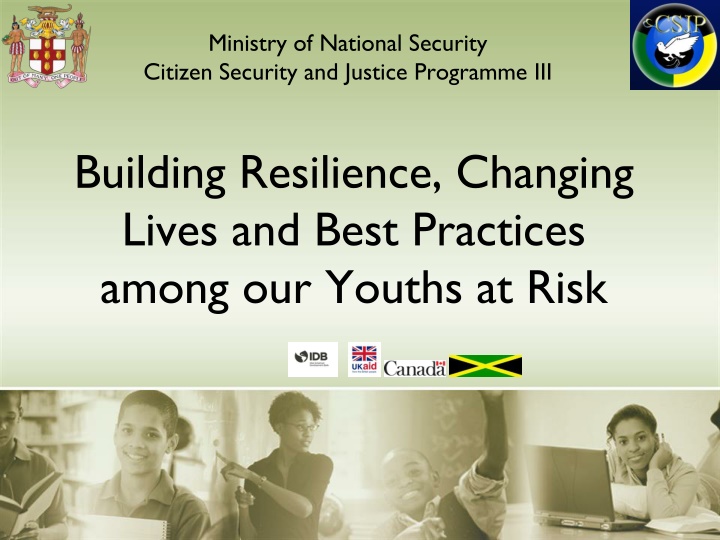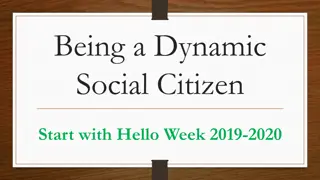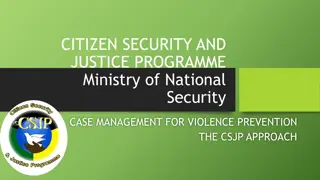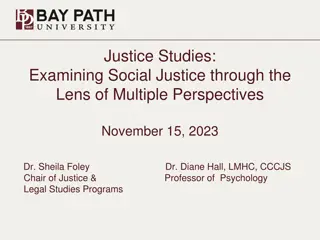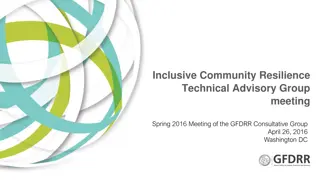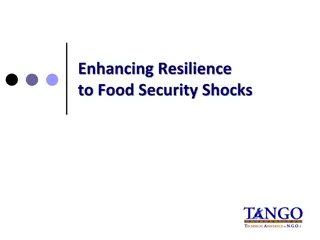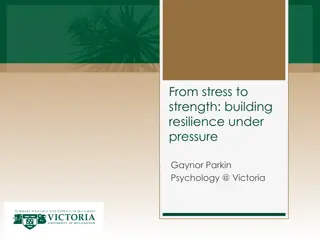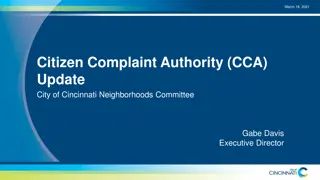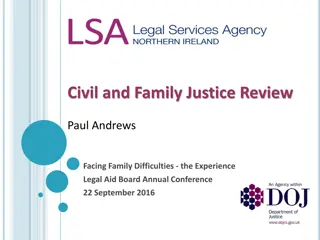Building Resilience and Changing Lives: Citizen Security and Justice Programme III
The Citizen Security and Justice Programme (CSJP) III by the Ministry of National Security focuses on enhancing citizen security and justice in Jamaica through various components such as culture change, community governance, labor market attachment, and employability. The program aims to build resilience and transform the lives of at-risk youth in targeted communities by providing essential services and support. Partnerships with funding organizations like IDB, DIFID, DFATD, and GoJ play a crucial role in the program's success.
Download Presentation

Please find below an Image/Link to download the presentation.
The content on the website is provided AS IS for your information and personal use only. It may not be sold, licensed, or shared on other websites without obtaining consent from the author.If you encounter any issues during the download, it is possible that the publisher has removed the file from their server.
You are allowed to download the files provided on this website for personal or commercial use, subject to the condition that they are used lawfully. All files are the property of their respective owners.
The content on the website is provided AS IS for your information and personal use only. It may not be sold, licensed, or shared on other websites without obtaining consent from the author.
E N D
Presentation Transcript
Ministry of National Security Citizen Security and Justice Programme III Building Resilience, Changing Lives and Best Practices among our Youths at Risk
Overview The Citizen Security and Justice Programme (CSJP) III is a multi-faceted crime and violence prevention initiative of the Ministry of National Security which focuses on building community safety and security.
Overview Phase 1 (2001-2009) started in 9 communities (August Town, Grants pen/Barbican, and Fletcher land, Hanna Town, Denham Town, Trench Town, Waterhouse, Towerhill and Drewsland). Phase 11 (2009-2013) expanded to 50 communities ,after evaluation of Phase 11 and lessons learned it was decided to continue with a phase 111 during which would gradually transfer services to line ministries agencies and departments. Phase 111 (2013-2019) , 50 pre-selected communities which are located in the Kingston Metropolitan Area, St. James, St. Mary, Westmoreland, St. Ann, Clarendon, and St. Catherine.
Our Funding Partners IDB, DIFID, DFATD and GoJ
CSJPs Objective ToEnhance Citizen Security and Justice in Jamaica in 50 target communities.
CSJPs Components: 1. Culture Change and Community Governance 11. Labour Market Attachment and Employability 111. Community Justice Services
Component 1. Culture Change for Peaceful Co- existence and Community Governance Involves interventions to provide knowledge, skills and opportunities to change attitudes that tolerate or promote violence , activities include: Parenting education Counselling Gender equality Physiological services Violence interruption services Local governance structures such as Community Action Committees Construction and equipping of multipurpose centres and other infrastructure
Component 11. Labour Market Attachment and Employability Deliver comprehensive programs for selected youths at 3 different levels: Group 1: participants are highest job readiness, receive services such as vocational and on the job training, employment internship, job seeking and placement, support services to tertiary education and business development training. Group 2: intermediate job readiness, receive services such as on the job training and work orientation. Group 3: lowest job readiness, receive remedial education particularly literacy and numeracy skills that required to participate in advance training.
Component 111. Community Justice Services Seeks to increase access to justice services outside of the formal court system. Activities include: Expansion of Restorative Justice Program Child Diversion program (steering juvenile in conflict with the law from criminal charges) Legal Aid Services Mediation services in schools Expansion of Justice of the Peace Services Victim Services including women and children
Who are Youth at Risk? At-Risk Youth: Those that have fallen victim to a variety of risk factors that reduce their ability to succeed (Morris, 2000, Kronick, 1997). These youth grow up in circumstances that challenge their ability to stay on a positive life-course into adulthood (Region of Peel Health Review 2014). Risk Factors: Include but are not limited to low scholastic achievement, school dropouts, behavior problems, poor attendance in school, low socio- economic status.
Who are Youth at Risk? Monitored the development of all children born on the island at ages 1, 2, 10, 18, 32, and 40 years. 30% of the children studied were considered at-risk because they were born and raised in poverty, had experienced pre- or perinatal complications; lived in families troubled by chronic discord, divorce, or parental psychopathology; and were reared by mothers with less than 8 grades of education. Two thirds of these children developed learning or behavior problems by age 10 or had delinquency records and/or mental health problems by age 18. However, a third of the at-risk group grew into competent, confident and caring adults. The children who succeeded against the odds had protective factors at the individual, family and community level. (all phases focus on these 3 levels) Kauai Longitudinal Research 1955-1995:
Profile of Sample of at risk youths referred to CSJP Figure 1. Percent distribution of a sample of individuals referred to CSJP by risk factor present, % (n = 1666) Other 14.5 Parents unable/unwilling to supervise 12.8 Irregularly attends school/work 37.0 History of gang/violence 20.4 Substance abuse problems 31.6 Mental health problems/learning difficulties 19.4 Risk Factors Attitudes supportive of violence 25.0 History of carrying a weapon 32.8 2 violent/assaultive behaviours 35.5 Current justice system involvement 7.6 Justice system involvement before 14 yrs 8.3 Male 55.2 Lives in CSJP Community 99.5 0.0 20.0 40.0 60.0 80.0 100.0 120.0 Percentage (%)
Profile of Sample of at risk youths referred to CSJP by Gender Figure 2. Percent distribution of a sample of individuals referred to CSJP by risk factor present and sex, % (n = 1666) 15.5 Other 13.6 12.3 Parents unable/unwilling to supervise 13.3 32.9 Irregularly attends school/work 40.4 13.3 History of gang/violence 26.2 19.5 Substance abuse problems 41.5 13.9 Mental health problems/learning difficulties 23.8 Risk Factors Female 23.6 Attitudes supportive of violence 26.2 Male 23.8 History of carrying a weapon 40.2 27.6 2 violent/assaultive behaviours 42.0 4.6 Current justice system involvement 10.1 7.5 Justice system involvement before 14 yrs 9.0 0.0 Male 100.0 99.6 Lives in CSJP Community 99.5 0.0 20.0 40.0 60.0 80.0 100.0 120.0 Percentage (%)
Building Resilience prevents violence Levels of Interventions
Individual Level Counselling and psychological support Empowerment through education and training Life skills education Job placement and Employment opportunities
Family Level Family Level: Parenting Education Family Engagement Family Engagement Family Level: Parenting Education 62 Parent Trainers graduate from CSJP Parenting programme training
Community Level Capacity Building of Community Development Committees and other CBOs including youth clubs Community Infrastructure safe recreational space for youth and the wider community Support to community level programmes that engage youth marching bands, community orchestra
CSJP Builds Resilience Societal/National level: Social marketing campaigns for behaviour change Men with a Message reformed men share their story of change with youth, schools, communities
CSJPs Best Practices Providing Stipend to individuals to assist with transportation and lunch. Management and monitoring of attendance (through attendance registers). Monitoring of participants through progress reports completed by host organization employment internship programme and on the job).
CSJPs Best Practices Job Readiness workshops (participants exposed to dress and deportment, interview tips and techniques, resumes and application letters writing, effective communication in workplace, reporting structure etc.) and role plays of areas learnt. Development workshops (workshops held during training to address issues encountered on the job , EIP or permanent placement). Providing Life Skills training (616 participants :211M, 405F).
CSJPs Best Practices Dedication and Commitment of CSJP staff. Use of Psychosocial education training (2137 :773M, 1364F). Monitoring of persons placed in permanent jobs / job retention (phone calls and visits to organizations. (1005 persons placed in permanent jobs including EIP and on the job placement).
CSJPs Best Practices Adoption of a Case Management Approach where persons are managed from they enter CSJP to their exit through referral or job placement etc.
Finally Challenges Limited private sector support to provide on-the-job placement and employment opportunities for youth. Lottery scam in the Western Region has given youth unrealistic expectations of wealth. Lack of opportunities for literacy and vocational skills training for youth in the Western Region (few sites provide quality training). Cultural apathy to counselling and psychological services.
